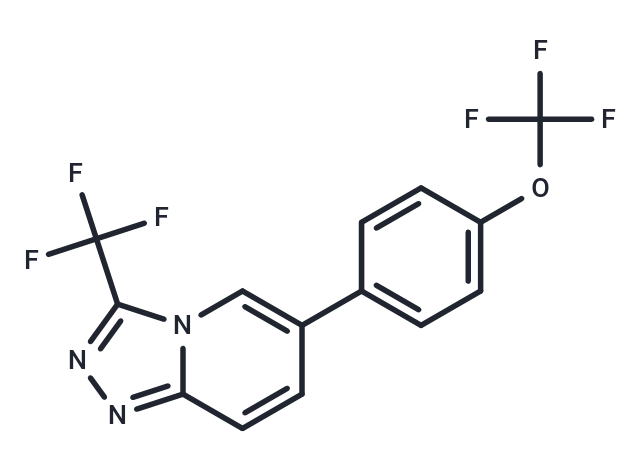Shopping Cart
- Remove All
 Your shopping cart is currently empty
Your shopping cart is currently empty
GS967 is a potent, and selective inhibitor of cardiac late sodium current (late INa ).

| Pack Size | Price | Availability | Quantity |
|---|---|---|---|
| 2 mg | $30 | In Stock | |
| 5 mg | $48 | In Stock | |
| 10 mg | $72 | In Stock | |
| 25 mg | $162 | In Stock | |
| 50 mg | $298 | In Stock | |
| 100 mg | $522 | In Stock | |
| 200 mg | $756 | In Stock | |
| 500 mg | $1,170 | In Stock | |
| 1 mL x 10 mM (in DMSO) | $53 | In Stock |
| Description | GS967 is a potent, and selective inhibitor of cardiac late sodium current (late INa ). |
| Targets&IC50 | Late INa:0.13 μM |
| In vitro | GS967 at concentrations of 10, 100, and 300 nM fully counteracts ATX-II's (10 nM) ability to prolong and vary the action potential duration (APD) in ventricular myocytes. It demonstrates an approximate IC50 value of ~10 nM and reduces the beat-to-beat variability of APD[1]. |
| In vivo | GS967 effectively mitigates and reverses the proarrhythmic consequences induced by the late INa enhancer ATX-II, the IKr inhibitor E-4031, as well as methoxamine, 1 clofilium, and ischemia-induced arrhythmias. It significantly reduces the proarrhythmic effects of these agents and suppresses ischemia-induced arrhythmias. Additionally, GS967 decreases INaP in a frequency-dependent manner, showcasing a use-dependent block (UDB) that is more potent than that of ranolazine and lidocaine, with an IC50 of 0.07 μM compared to 16 μM and 17 μM respectively. This compound also maintains its effectiveness against a common long QT syndrome mutation (delKPQ) and prevents ischemia-induced alternans in both the left atrium and ventricle, alongside reducing depolarization and repolarization heterogeneity induced by ischemia. Notably, GS967 does not affect heart rate, arterial blood pressure, PR and QT intervals, or QRS duration, although it slightly reduces contractility during ischemia, aligning with late INa inhibition effects. |
| Kinase Assay | The IC50 of LY-364947 at different enzyme concentrations are determined by the filter-binding assay. Typically, 40 μL reactions in 50 mM HEPES at pH 7.5, 1 mM NaF, 200 μM pKSmad3(-3), and 50 mM ATP containing a titration of each inhibitor with concentrations of 1600, 800, 400, 200, 100, 50, 25, and 0 nM are incubated at 30°C for 30 min. The IC50 is calculated using a nonlinear regression method with GraphPad Prism software. The binding type is determined by plotting the correlation between enzyme concentrations and IC50 values. |
| Synonyms | GS458967 |
| Molecular Weight | 347.22 |
| Formula | C14H7F6N3O |
| Cas No. | 1262618-39-2 |
| Smiles | FC(F)(F)Oc1ccc(cc1)-c1ccc2nnc(n2c1)C(F)(F)F |
| Relative Density. | 1.52 g/cm3 (Predicted) |
| Storage | Powder: -20°C for 3 years | In solvent: -80°C for 1 year | Shipping with blue ice/Shipping at ambient temperature. | |||||||||||||||||||||||||||||||||||
| Solubility Information | DMSO: 50 mg/mL (144 mM), Sonication is recommended. | |||||||||||||||||||||||||||||||||||
Solution Preparation Table | ||||||||||||||||||||||||||||||||||||
DMSO
| ||||||||||||||||||||||||||||||||||||

Copyright © 2015-2025 TargetMol Chemicals Inc. All Rights Reserved.